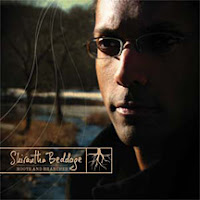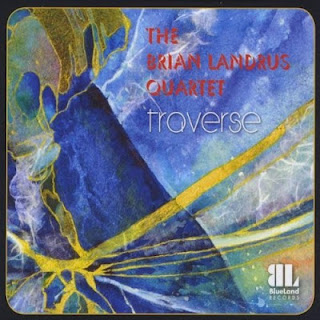Category: Album: Review
Shirantha Beddage – Roots and Branches (2006)
 Few albums make me want to find the player and enroll in his college but this album makes a great case for Beddage’s music department at Humber College (Toronto, Canada). Beddage proves wrong the Mencken quote that “those who can, do; those who can’t, teach”. It is clear that his love and passion for music has given this album its shine.
Few albums make me want to find the player and enroll in his college but this album makes a great case for Beddage’s music department at Humber College (Toronto, Canada). Beddage proves wrong the Mencken quote that “those who can, do; those who can’t, teach”. It is clear that his love and passion for music has given this album its shine.Jonah Parzen-Johnson – Michiana (2012)
 |
| http://jonahparzen-johnson.com |
Jonah Parzen-Johnson – Michiana (2012)
Collective Identity – The Mass (2000)
Collective Identity – The Mass (2000)
TAKE AWAY: This album is at times hard to listen to but rewards the listener with moments of advanced techniques and unique arrangements. Do I recommend you buy this album? Yes, if you like modern semi-abstract melodies and dissonant tonalities in small ensembles. If you don’t then spend your money on Alex Harding’s other albums.
Line Up:
Frank Basile – Modern Inventions (2012)
Frank Basile – Modern Invention (2012)
Cologne Saxophone Quintet Feat. Bob Mintzer – YO! (2005)
YO! – Cologne Saxophone Quintet featuring Bob Mintzer
Adam Schroeder – A Handful Of Stars (2010)
Baritone Saxophone, Adam Schroeder – A Handful Of Stars (2010)
 There is a pensive moment, just after you hit play on your music player, as you wait for the first note from the soloist on that new CD. You wait as the rhythm section sets the scene and builds up to the moment when the soloist must speak. It is at that moment that I am most nervous. My mind races with 2 thoughts over my decision to purchase this album. It is not until the soloist takes their first breath into the album that I can rest easier. For this album the first note Is the most important. Adam Schroeder’s first note sets the stage for the magic that follows.
There is a pensive moment, just after you hit play on your music player, as you wait for the first note from the soloist on that new CD. You wait as the rhythm section sets the scene and builds up to the moment when the soloist must speak. It is at that moment that I am most nervous. My mind races with 2 thoughts over my decision to purchase this album. It is not until the soloist takes their first breath into the album that I can rest easier. For this album the first note Is the most important. Adam Schroeder’s first note sets the stage for the magic that follows.The Brian Landrus Quartet – Traverse (2011)
Brian Landrus Quartet – Traverse
When I think of a sensual saxophone tone my first thoughts lean towards the sultry tenor playing a bluesy piece in smoke filled club as people drink hard liquor and snap their fingers. Sure it’s cliched but until I heard this album I was pretty comfortable with that vision. After listening to Brain Landrus’ amazing sensitivity I knew that I would have to expand my vision to include the baritone as a “saxually” capable instrument.
 In keeping with my love of unique voices and tone I have to lead this review with a discussion of tone, and what a tone it is. His baritone tone is close up and intimate. It lacks the strong projection and distinct buzz easily identified with more modern setups. In fact I was so sure that he was playing a Otto Link that I had to visit his website to confirm. Wouldn’t you know, yes he does play several Links. Personally I have always loved the compact and centered, though somewhat stuffy, tone links bring to the baritone sax.
In keeping with my love of unique voices and tone I have to lead this review with a discussion of tone, and what a tone it is. His baritone tone is close up and intimate. It lacks the strong projection and distinct buzz easily identified with more modern setups. In fact I was so sure that he was playing a Otto Link that I had to visit his website to confirm. Wouldn’t you know, yes he does play several Links. Personally I have always loved the compact and centered, though somewhat stuffy, tone links bring to the baritone sax.
For a great example of spectrum of Landrus’s tone listen to “Soul and Body”. This unaccompanied solo takes the listener on a journey. Visiting advanced techniques like multiphonics, split tones, subtones, and wide dynamic ranges. Landrus did this while still making the entire experience moving and musical. The piece is placed just ahead of “Body and Soul” on the album and adds another dimension to that oft recorded tune just by being in proximity.
Also on auditory display is Landrus on bass clarinet. I’ll admit that outside of Bob Mintzer, I have very little listening experience to bass clarinets in jazz. With that in mind feel free to take this and anything else I say with a grain of salt. With the disclaimer stated I will say that his ability to tell a story is equal on bass clarinet as it is on the baritone saxophone. Landrus displays fantastic control and expressiveness. The way Landrus presents the bass clarinet makes it feel like the brother to the baritone saxophone and not like a gimmick. The two tones compliment without showing the other up.
As you might imagine, Landrus didn’t do it alone. He is accompanied by what I can only describe as some of the most sensitive and aware musicians available. Simply listen to Michael Cain on the track “Lone“. His use of empty space and a quiet confidence pushes the track along in a way that makes you long to hear how Landrus will fill the spaces when he comes in later. Simply put this track is sexy and just a bit melancholic.
Lineup:
Brian Landrus – Baritone Saxophone, Bass Clarinet
Lonnie Plaxico – Acoustic Bass
Michael Cain – Acoustic Piano
Billy Hart – Drums
TAKE AWAY: Buy this album. That’s it! Nothing more, just buy it. It’s worth the money at 2x the price to have a great musician playing originals and standards on demand from your CD player. At the very least you have a stellar example of what a vintage Link and Mk VI bari can do in the hands of an expert.
Brian’s website: Brianlandrus.com
Henk Van Twillert – Bach: Cello Suites (2008)
To date I haven’t reviewed any classical music. This is not because I don’t love it. Actually like many students, it was my first foray in music. It served as the musical foundation for my learning and is my second musical love. Sadly, due to the fact there there is very little classical baritone music produced and just as little repertoire written for the horn, there was little for me to write about. As a classical alto player I was awash with music but as a baritone player I was forced to play alto literature or arrangements from other instruments. Sadly none of these included the Bach Cello Suites as heard on this album.
Jim Hartog – From Here To There (1988)
 This album was suggested to me by a reader and I had to find it on Amazon. Until this album I was only familiar with Jim Hartog as the baritone player of 29th Street Saxophone Quartet. This album is his project outside of that group. This album proved to be an interesting listen and at times a frustrating one. Track after track presented me with something different from the previous track and in some ways echoed his time spent with 29th Street Sax Quartet.
This album was suggested to me by a reader and I had to find it on Amazon. Until this album I was only familiar with Jim Hartog as the baritone player of 29th Street Saxophone Quartet. This album is his project outside of that group. This album proved to be an interesting listen and at times a frustrating one. Track after track presented me with something different from the previous track and in some ways echoed his time spent with 29th Street Sax Quartet.
Whom I won’t review
 I’ve been asked why it is that you will never see reviews of music by Gerry Mulligan or Pepper Adams on this blog. They are arguably the most influential baritone players in jazz history after Harry Carney and quite possibly the most prolific. It is not as though i don’t don’t own plenty of both artists. In fact my favorite Mulligan album is his 1957 release “Getz Meets Mulligan in Hi-Fi”. My favorite Adams album is his 1961 release “Out of This World: The Complete Warwick Sessions“.
I’ve been asked why it is that you will never see reviews of music by Gerry Mulligan or Pepper Adams on this blog. They are arguably the most influential baritone players in jazz history after Harry Carney and quite possibly the most prolific. It is not as though i don’t don’t own plenty of both artists. In fact my favorite Mulligan album is his 1957 release “Getz Meets Mulligan in Hi-Fi”. My favorite Adams album is his 1961 release “Out of This World: The Complete Warwick Sessions“.
I feel that every baritone saxophonist regardless of musical ambition should devote time and a little money into acquiring and devouring the music of these giants. These men have have defined their genre’s and redefined the role baritone saxophonists have in jazz music. The brilliant compositions of Mulligan and the effortlessness of Adam’s technique is without question the best thing that happened to baritone saxophones since its creation by Adolph Sax.
Now that I have doted over them I will explain why I won’t add to the cacophony of reviews already in print since the 1950’s. Critics from all walks of life and musical experience have reviewed the albums of both of these men throughout the ages. Is there anything new that I would hear that the calibrated ears of more practiced reviewers may have missed since the the original release date? In my practice I have not found a nuance in the music that has not been adequately discussed by other reviewers. With that in mind, and the fact that both of these men have since passed away, there is not likely to be a new release anytime soon unless like Tupac their holograms will be gracing a digital screen for new virtual performances.
Like many other bari players I simply listen to these sax titans and enjoy the magic of their creations for what they are, pure and simple joy. Joy as expressed on the apple of Adolph’s eye the Baritone Saxophone.
Ronnie Cuber – The Scene is Clean (1994)
What do you get when you combine the dinner scene from The Nutty Professor with the skill and talent of a world class saxophone player Ronnie Cuber? Why, The Scene is Clean of course.
Frank Basile – Modern Inventions (????)
 |
| http://kcstage.blogspot.com |
Normally I would be discussing the amazing phrasing, tone, and technique used on an album, but not this time. The reason is that this album is not yet released and may not be if we don’t help. Frank Basile is one of my favorites of the current generation baritonists and I have his album “Thursday the 12th” in my to-do list when it is in stock at Amazon. This yet to be released album looks to have all the Adam’ish flare and Frank’s unique voice all over it and it deserves to be shared with the community.
What can we do to help? Head over to his Kickstarter page and offer your support. Even $1 will help complete this project and if you donate enough you could find yourself being made dinner by Frank himself in his New York apartment. Frankly I’d take a 1 hour lesson any day.
Here is the link to his Kickstarter page. Frank Basile’s New Sextet Recording Please take a moment and do what you can to bring great jazz to everyone. Lets not forget you would get bragging rites to partially funding the album of a top level musician.
**** UPDATE ****
Thanks to everyone for following the link above and helping fund his project. I will bring you my views on this album when i receive it. Keep an eye out!
Recommended Recordings?
As you can image I have a lot of critical listening and writing ahead of me. This has left me with the need to find more Baritone and bass saxophone focused music to review. So with that in mind, I am asking you my readers to please suggest some music for me and everyone else to listen to. I am looking forward to the responses.
James Carter – Chasin’ the Gypsy (2000)
While I’m not the worlds most dedicated James Carter fan I do recognize the guy as a virtuoso on the saxophone. After watching him play the Bass saxophone on Youtube videos I decided to spend some time listening to him play it on this 2000 release.
The first thing to get out of the way is that i didn’t like any recording of James on bass sax as displayed on Youtube. Aside from the the lack of quality audio and clips which lacked musical context in most cases, I just couldn’t stand his aggressive attack of the horn. It was as though he wanted to punish the horn for being so big and heavy. Determined not to let poor Youtube camera work deter me from finding joy in his work I ordered a CD. Thank goodness I did, my ears were in for a surprise.
Before I get ahead of myself, this album is a tribute to the music of Django Reinhardt. This fact with the knowledge that James Carter was playing his bass was enough to make me pull the trigger on this purchase. Well, that and knowing that his sister was playing violin. To that I must add that his sister is a great violinist and impressive improviser as evident in the back and forth licks on the track “Avalon” and a few other solo sections scattered throughout the album.
Rather than take apart the entire album I will focus on the songs in which Carter plays bass saxophone. This is a blog dedicated to bari and bass saxes so what else would you expect. Before I leave the the other 6 non-bass tracks behind I will say that they are common James Carter. Full of flourishes, slap tonguing, musical overindulgence, and a flare for the extravagant. Carter brings his unique voice to everything that he plays. Love him or hate him he is still making more money than 99.9% of the saxophonist of the world and produces albums of legit jazz almost yearly.
Now for what we all came to discuss; bass saxophone. Carter kicks this album off in a bass’tastic way. “Nuages” is a gypsy swing tune by Django Reinhardt (from this point on known as D.R.) and Carter holds true to the feeling of the original. His playing here is lyrical and deliberate. He manages to curtail some of his usual musical bravado and really falls into the lilting swing style. This is the track I feel best represents what he can do with a bass saxophone.
The second tune “Artillerie Lourde” is a driving swing tune by D.R. which Carter falls back to his more tenor-like playing style. His use of slap tongue, split tones, and multiphonics are in play towards the end of the track. While impressive from a technical point of view I don’t feel they added a great deal to the musical narrative laid out earlier in the track. Now if you are a fan of Carter then you know this is par for the course.
The last of the bass tracks is the tune “I’ll never be the same” by D.R.. This track features the bass saxophone in a supportive but lyrical role. Carter adds firm support to Romero Lubambo’s Django inspired lines until about half way through the track. At this point he opens his solo with a powerfully subdued line. Of course he then takes it close to the “playing like a tenor player” line and back again. But at the end of his rather brief solo section he returns to the support role. I feel that in this one track Carter has defined a modern role for this often ignored horn.
I would be remiss not to discuss his tone and equipment. Carter has a unique tone on the bass saxophone. His setup on horn is likely an International Winds IW-661 bass saxophone and played with a Geoff Lawton baritone saxophone mouthpiece. I cannot confirm this exact setup as there is very little written on his bass saxophone setup but the evidence is that he’s been seen with an IW basss saxophone and his choice of mouthpieces on all of his horn are Geoff Lawton’s. With that setup in mind it is not at all surprising that his tone isn’t as warm as that of Adrian Rollini or as broad in depth as the amazing tone of Bert Brandsma.
Take Away: The 3 bass saxophone tracks are some of my favorite featuring this underutilized horn. Would I buy the album again for just these three tracks? No, I would purchase them on iTunes individually and save a few dollars.
Bass saxophone tracks:
Nuages
Artillerie Lourde
I’ll Never Be The Same
Personnel:
James Carter (soprano saxophone, tenor saxophone, bass saxophone)
Jay Berliner (steel guitar)
Romero Lubambo (nylon-string guitar)
Regina Carter (violin)
Charlie Giordano (accordion)
Joey Baron (drums)
Cyro Baptista (percussion)









